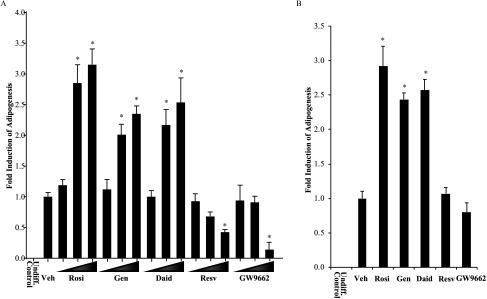Figure 3.
Pro- and anti-adipogenic effects of phytoestrogens in mammalian adipocytes. (A) 3T3L1 mouse pre-adipocytes were grown to confluence and then induced to differentiate using an 8-d protocol (see the “Methods” section). Cells were co-incubated with vehicle (Veh) or various concentrations (, , ) of agonist Rosiglitazone (Rosi), Genistein (Gen), Daidzein (Daid), Resveratrol (Resv), or antagonist GW9662 during the entire differentiation period with the media replaced every 2 d. After 8 d, cells were assayed for adipogenesis using a quantitative fluorescent assay (AdipoRed™ Adipogenesis Assay Reagent). Cells were co-stained with nuclear dye Hoechst 33342, and lipid accumulation values were calculated between treatments by normalizing lipid intensity values to Hoechst intensity. Graphical values for each treatment represent comparison with Vehicle (set at 1). Each data point is the average of three independent experiments; individual experiments included four technical replicates used for each treatment. An undifferentiated control (Undiff. Control) sample is included for comparison. Bars represent . * for comparison between Veh and each treatment. (B) Human mesenchymal stem cells were grown to confluence and induced to differentiate for 8 d. Cells were co-treated throughout with Veh or Rosi, Gen, Daid, Resv, or GW9662. Results were assayed and normalized as described above. * for comparison between Veh and each treatment.

